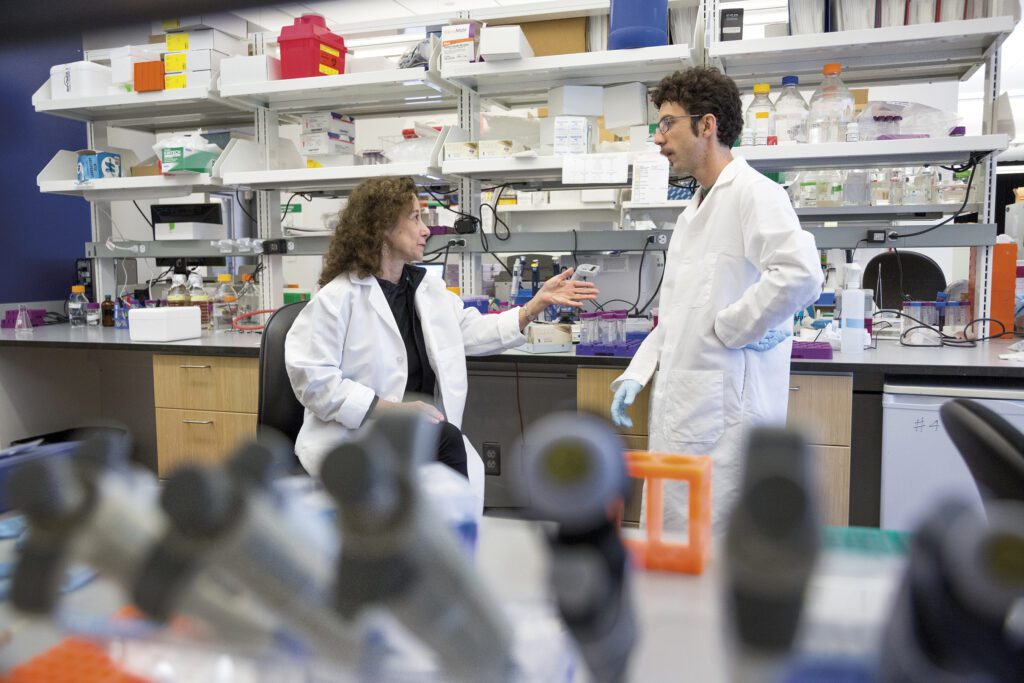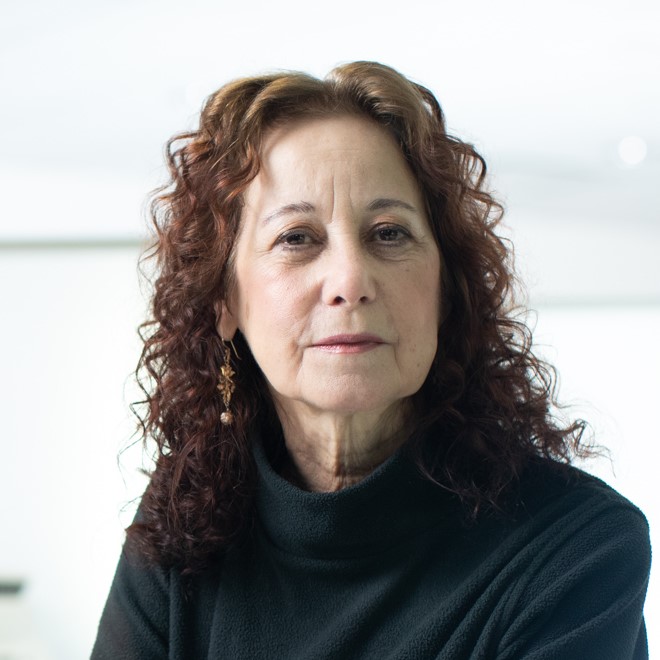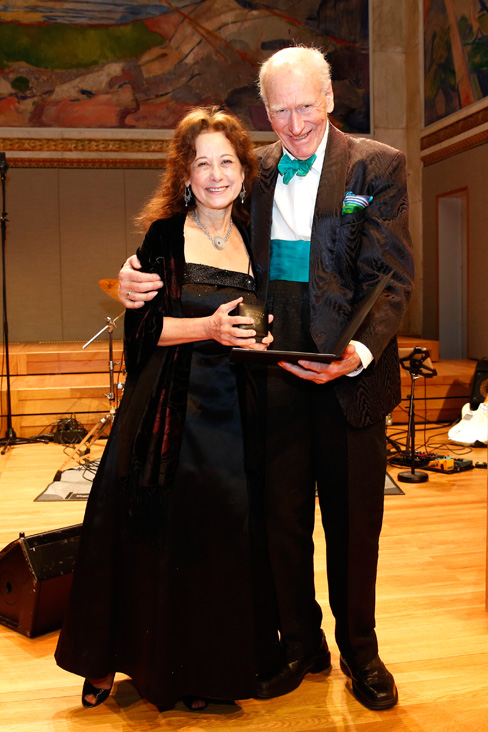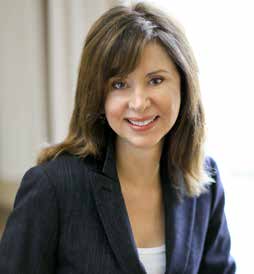Discovering the mechanisms of senescence
While cracking the code on why we age is an ambitious and encompassing endeavor, cracking the glass ceiling of science, especially for a woman, is probably just as elusive. Although the field is changing, science for decades was the purview of men and research was largely conducted using male subjects, animals, and cell cultures. But no longer.
Despite the odds, one woman, Judith (Judy) Campisi, Ph.D., approachable and soft-spoken, is an understated powerhouse and science pioneer who has achieved both endeavors. In 2018, she was elected to the National Academy of Sciences, one of the highest recognitions in science, for her pioneering work on cellular senescence—an important discovery toward unlocking the code on why we age. Members are elected to the National Academy of Sciences “in recognition of their distinguished and continuing achievements in original research. Membership is a widely accepted mark of excellence in science and is considered one of the highest honors a scientist can receive.”
EARLY DAYS
Her path, however, was not always straightforward. Campisi was the first in her family to attend college after attending an all-girls Catholic high school in New York City. Upon entering junior college when selecting her courses, she admits, “My guiding principle was I wanted to be where the boys were—and that was science, it was chemistry. I was pretty good at it, but my motivation was, unfortunately teenage hormones.” Upon finishing her 2-year degree, she pursued short stints at odd jobs, eventually reaching the conclusion, “I didn’t want to spend my life being un-gainfully employed. I remembered I enjoyed chemistry, aside from the boys.” Thus she began her long love affair with science. After completing a bachelor’s degree in chemistry at State University of New York at Stony Brook, she continued her studies there to receive her Ph.D. in biochemistry, then did a postdoctoral fellowship at the Dana Farber Cancer Institute in Boston.

THE ROAD NOT TAKEN
In learning more about Judy Campisi and her career path, Robert Frost’s famous poem, “The Road Not Taken,” keeps coming to mind. “Two roads diverged in a wood, and I—I took the one less traveled by, And that has made all the difference.” And, in Campisi’s case it did.
Having secured a faculty position at Boston University Medical School in 1984, her mentor, Arthur Pardee, urged her to pursue a project that was not mainstream. Campisi reflects, “at the time, oncogenes had just been discovered; everyone was jumping on that.’ She continued, “I decided I should try to study the flipside because my lab was small, and all these giants were working on oncogenes. I decided to study why we don’t get cancer, which was tumor suppression.” This groundwork ultimately led to her eventual breakthrough research on senescence—a process that drives chronic inflammation, tissue degradation, and the promotion of disease as we age.
At Boston University, she received her first grant to explore senescence, a known tumor suppressor as a potential contributor to aging. As she began her research, it became clear that senescence does contribute to aging, but exactly how was yet to be understood. Senescent cells stop dividing. The hypothesis popular in the early 1990s was that the secretions released from these cells caused cell division to cease. Once again, Campisi took the road not taken—considering the possibility that it might be the other way around—that the secretions came after cell division stopped and they inflamed surrounding cells. “They (the secretions) affect surrounding tissue. That’s what aging is about,” she said.
In 1996-97, she put forth her theory of aging in two “prophetic papers,” one in Cell and the other in the Journal of the American Geriatrics Society. It took five years to gather enough data to demonstrate how this might happen in a mouse. That study appeared in the National Academy of Sciences of the United States of America and, in 2008, her team described what is now known as the SASP—the senescence- associated secretory phenotype—in PloS Biology. It became one of the most cited papers in biomedical research.
During the 1990s, Campisi worked at the Lawrence Berkeley National Laboratory, focusing mainly on cancer. By 1999, she ran the Department of Cell and Molecular Biology and co-directed their Center for Research and Education on Aging in conjunction with the University of California, Berkeley. In 2001, she joined the faculty at the Buck Institute in Novato, California, which solely focuses on the science of aging and where there was a tremendous opportunity for ongoing collaboration. There, she also enjoys mentoring younger scientists. Reflecting on her lab there, she says, “Modern medicine has enabled us to extend lifespan—often at the expense of healthspan. My lab is focused on disrupting one of the major drivers of aging. Our goal is to enable more healthy years of life.”

SENESCENCE AND INFLAMM-AGING: WHY IT MATTERS
Today, Campisi’s work is widely credited for the emerging focus on “inflamm-aging” based on her scientific body of work on senescent cells—a process whereby cells permanently lose the ability to divide when they are stressed. While senescence suppresses cancer by halting the growth of premalignant cells, it is also suspected of driving the aging process. Senescent cells accumulate over time as we age and release a continual cascade of inflammatory secretions. This process sets up the surrounding tissue for a host of maladies, including arthritis, atherosclerosis, and late life cancer.
Campisi explains, “The correct way to think about senescence is that it’s an evolutionary balancing act. It was selected for the good purpose of preventing cancer—if (cells) don’t divide, (they) can’t form a tumor. It also optimizes tissue repair. But the downside is if these cells persist, which happens during aging, they can become deleterious. Evolution doesn’t care what happens to you after you’ve had babies, so after around age 50, there are no mechanisms that can effectively eliminate these cells in old age.”
FROM LAB BENCH TO BEDSIDE
Moving the science from lab bench to bedside in 2016, Campisi became a scientific co-founder of Unity Biotechnology (which incubated at the Buck) and is now based in South San Francisco, California. The company’s most promising drug candidate is in Phase II clinical trials for age-related macular degeneration and diabetic macular edema. The candidates are in a new class of drugs called senolytic; that selectively eliminate senescent cells. Campisi says, “Unity’s drug is designed to cause chronically present senescent cells to simply die and go away in a manner that does not impact surrounding tissue. Preclinical work in mice has successfully addressed other age-related diseases, including cancer relapse and metastasis and chronic lung disease.”

In 2015, Campisi became the first recipient of the Olav Thon Foundation Prize in medical and natural sciences. According to the foundation, “Campisi’s research is highly acclaimed in the international community of scientists … she has contributed significantly in turning ‘ageing’ into an exciting and prestigious domain of research. Considering the aging of the population, it is vital to secure for our seniors a healthy life, not only for their own sense of wellbeing but also for their being able to contribute to their social environment, this is where the larger promise of Campisi’s research lies.” Campisi is the recipient of numerous other awards, including the Longevity Prize from the Ipsen Foundation.
If anyone questions Campisi’s stature as a powerhouse, one only need look at her CV—an impressive litany of more than 15 pages recapping her many academic positions, major research/achievement awards, major scientific review and advisory positions, editorial board memberships, publications and citations, scientific engagements, and the many post doc fellows and graduate students she has trained and mentored. I don’t know about you but I’m beginning to feel like an underachiever. Honestly, how could anyone accomplish so much?
Easy—if you are Judy Campisi. And all the while she is so modest about it all. Perhaps one of her greatest strengths is her ability to translate hard- core, complicated science into plain English for folks like us.
WHAT’S NEXT?
There is no question Campisi is a legend and leader in her field; someone to keep an eye on. Curiosity is her laboratory, courage and tenacity her currency. What road she follows next, we will have to wait and see. If the past is any prediction of her future—there’s lots more to come. Stay tuned.
To follow Campisi and other scientists like her, join the Buck (www. BuckInstitute.org)

Lydia is a passionate advocate of healthy living. She has launched and positioned many health and wellness-related companies, products, technologies, and organizations receiving more than 100 awards nationally and internationally. Her focus in the health sector is specifically on healthy living, aging and longevity. She is a partner and investor in several recognized national brands. She sits on the board of the Buck Institute for Research on Aging whose mission is to eliminate the threat of age-related disease for today’s and future generations. It is the only independent research organization globally dedicated to extending the healthy years of life. Like the scientists at the Buck, Graham envisions it will be possible for people to enjoy life at 95 as much as at 25. To support Buck’s mission, please visit www.buckinstitute.org.
